Custom Heating Solutions by HRX
At HRX, we specialize in providing innovative and reliable heating solutions tailored to meet the specific requirements of various industries. Our custom heating solutions range from flexible to rigid heaters, with precision-engineered elements and integrated components designed to optimize thermal management and performance.
Element Design
Insulation Type: Polyimide/Kapton, Silicone rubber, Epoxy Resin, and Mica
Heating Element Type: Wire wound or Etched foil.
While a Wire Wound element can be used with materials such as silicone rubber or mica, Etched Foil is more widely used in various types of heaters. Etched Foil features a chemically etched thin and flat metal track, much like the traces found on a printed circuit board, making it a popular choice for its precision and reliability.
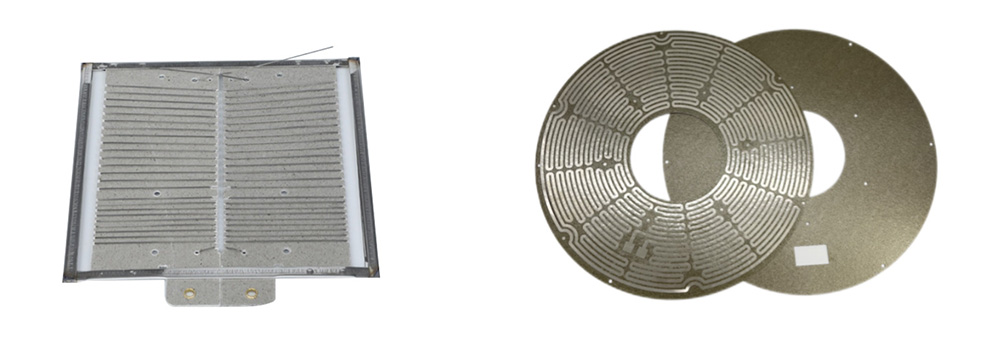
Element Patterns: Dual Voltage, 3-phase, Zoning and profiling.
Multiple heating circuits can be configured to support dual voltage and multiple zones. For dual voltage heaters, three leads are provided—one being a common, which is color-coded—for easy wiring. These heaters can be connected in series for higher voltage or in parallel for lower voltage, with options like 120/240 Vac or 240/480 Vac available.
Different circuit zones can be designed to address varying heating requirements, offering flexibility for specific heating needs.
For high-current, large-scale applications, three-phase circuits can be utilized. A profiled foil element can be incorporated to evenly distribute wattage, helping to minimize temperature gradients by delivering additional heat where losses tend to occur, such as at edges or around mounting holes.
Outline Shapes: Holes, cutouts, and notches can be designed so the heaters accurately fit to the part.
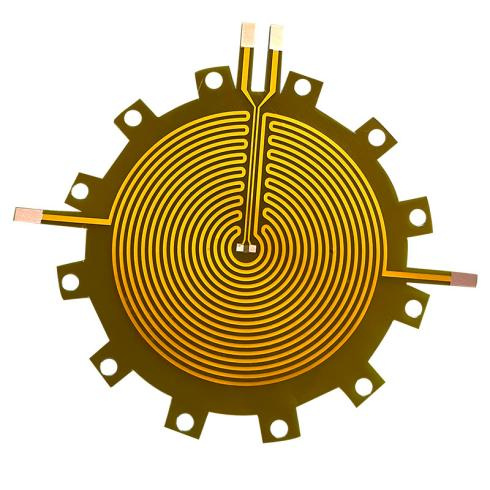
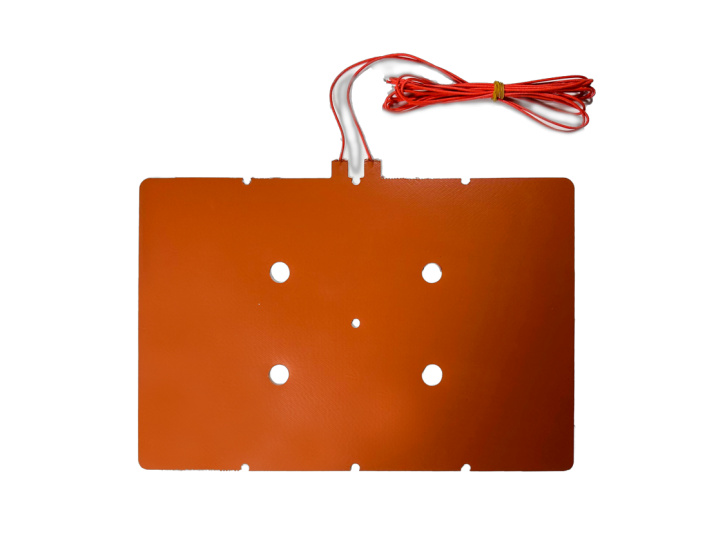
Leads Exit and connection tab: The power leads of the heater can be customized, and an unheated lead exit tab can be incorporated to prevent cold spots or to eliminate the bulge at the lead exit area when the heater is used in a compression application between plates.
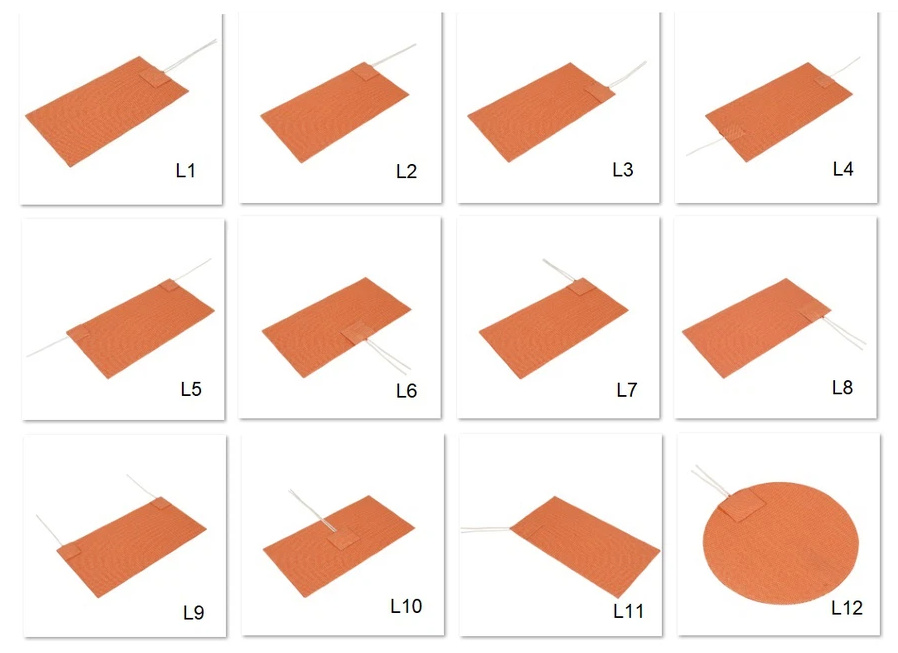
Integrated Components and Accessories
A) Heater Installation (PSA, Adhesive Application, Mechanical Fasteners):
Flexible heaters are highly adaptable and support various mounting techniques, but proper installation is key to ensuring optimal performance. The heater must maintain close contact with the heat sink, as any gaps can impede heat transfer and lead to hot spots, potentially causing premature failure.
Pressure Sensitive Adhesive (PSA):
This is the easiest installation method. With factory-applied PSA, you simply peel off the backing paper and press the heater onto the desired surface.
Adhesive Application:
Room temperature vulcanizing (RTV) silicone rubber adhesive is used for creating a strong, permanent bond. A thin layer of adhesive is applied between the heater and the surface, followed by using a roller to eliminate air bubbles. The adhesive should be allowed to cure for 24 hours for the best results.
Mechanical Fasteners:
These are ideal for temporary installations. Common mechanical fastening methods include spring hooks, Velcro, buckles and straps, boots with hooks and lacing, as well as snap fasteners.
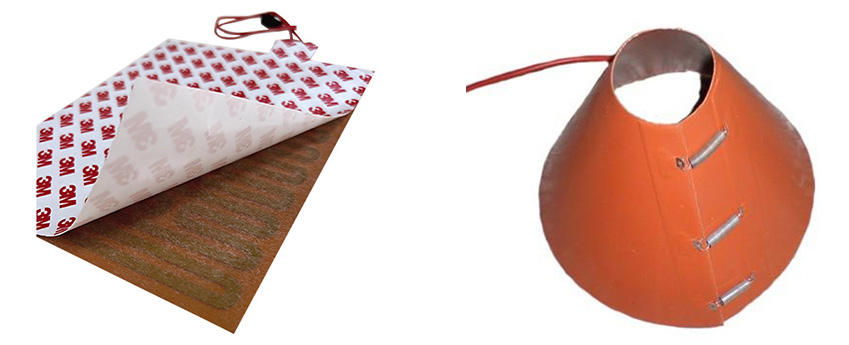
B) Thermal Insulation
To increase heater efficiency, silicone sponge rubber or EPDM insulation can be bonded to the top side of the heater. Typical thermal insulation thicknesses are 5mm, 8mm, 10mm.
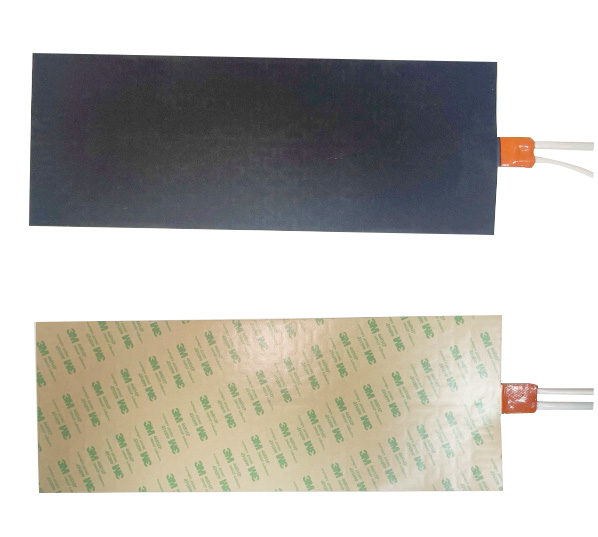
C) Temperature Control and Thermal Management (Adjustable Thermostat, Built-in Temperature Sensors, Digital Controller):
Heaters can integrate thermostats, temperature sensors, digital controllers, and thermal fuses as part of their design to enhance thermal management and ensure safety.
Electronic Controllers with Sensors:
For precise temperature control, electronic controllers paired with sensors are recommended over traditional mechanical thermostats.
Adjustable Mechanical Thermostats:
These thermostats allow users to set and maintain specific temperatures to achieve desired results. Encased in a silicone rubber overmold, they offer adjustable temperature ranges such as 0–80°C, 30–150°C, and 50–250°C.
Built-in Temperature Sensors:
Sensors like thermocouples, RTDs, and thermistors can monitor the temperature of either the heat sink (the part being heated) or the heater’s surface. In silicone heaters, sensors are secured with a silicone rubber or fiberglass protective patch vulcanized to the heater. For Polyimide heaters, sensors are attached using epoxy. The picture below shows an integrated PT100 sensor with a Polyimide heater.
Thermocouples:
A wide range of thermocouples can be applied almost anywhere on the heater's surface. The most commonly used types are "J" and "K."
Resistance Temperature Devices (RTDs):
RTDs offer a highly accurate and stable temperature measurement by changing resistance in a linear relationship with temperature. Thin film PT100 or PT1000 sensors are popular choices and can also be integrated into probe designs.
Thermistors NTC:
Thermistors are resistive-based sensors but are limited to specific temperature ranges due to their non-linear response. They are typically used for single-point temperature measurements.
Thermal Fuses:
These one-time-use devices provide over-temperature protection in case of control system failures. To ensure optimal performance, testing is recommended to determine the ideal placement and activation temperature for the fuse.
Digital Temperature Controller:
Ideal for applications requiring accurate temperature management. This ready-to-use solution comes fully equipped with a plug and pre-fitted sensor, eliminating the need for complex wiring and ensuring precise temperature control with ease. (like the below picture, to be configured by customer normally).
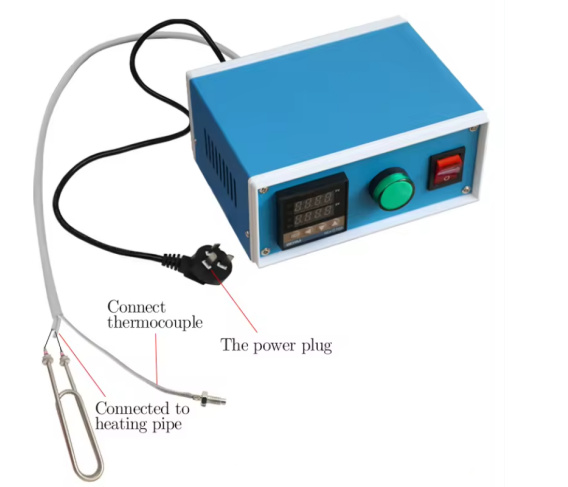
Enhance Your Application with HRX Custom Heating Solutions
Whether you need a flexible heater for a small device or a robust solution for large-scale industrial applications, HRX's custom heating designs, integrated accessories, and precise temperature controls will ensure optimal performance. Contact us to learn more about how our solutions can be tailored to your specific heating needs.

We offer a wide variety of high-efficiency heaters and heating element.Such as polyimide/kapton heaters,silicone rubber heaters,PET transparent heaters, thick film heaters,PTC heaters, mica heaters,epoxy resin heaters and graphene heating film.